I have contracted for a handsome memorial stone to mark the site of Fort Raleigh, with an appropriate inscription telling the story of the attempted settlements and the fate of the Colonists etc. Edward Graham Daves, July 2, 1896
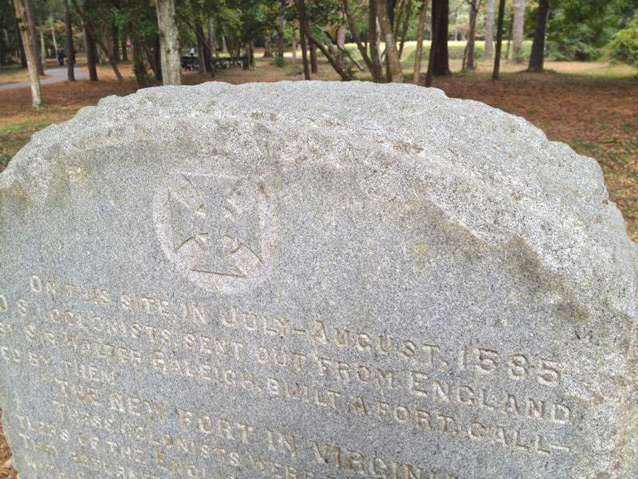
National Park Service
As Roanoke Island was being settled during the eighteenth and nineteenth centuries, the location of the earthwork associated with Sir Walter Raleigh’s colonies remained generally neglected, but the site was never lost to memory. Throughout the nineteenth century, Fort Raleigh was assumed to be the settlement location for both of the colonies established by Raleigh on Roanoke Island. Interested individuals traveled to the property, including President James Monroe in 1819.
Although land titles are unclear until the mid-nineteenth century, the Dough family apparently was in possession of the fort tract by 1820. In 1849, Thomas A. Dough formalized his ownership of the land by receiving an official grant from the State of North Carolina. Fort Raleigh would remain in possession of the Dough family until efforts to preserve and mark the site began during the late nineteenth century. By that time, the old fortification was widely known by its modern name. Raleigh’s original colonists, of course, did not use the name “Fort Raleigh” themselves. Instead, those who made the earliest attempts to commemorate and preserve the site of the fort chose to promote it by that name.
In the 1870s and 1880s, less than twenty years after the end of the Civil War, efforts began to commemorate historic sites and battlefields throughout the United States. Ostensibly as a means to commemorate sites associated with the American Revolution on its centennial, the preservation of these sites likely also evolved from the vast losses during the Civil War and the need to cope with, understand, and memorialize those losses. In addition, xenophobia in the United States reached its zenith in the years following the Civil War due to the influx of non-English immigrants, leading to a renewed interest in commemorating "English" history in North America.
In the case of Fort Raleigh, North Carolina Senator Zebulon B. Vance was the first to attempt to commemorate the site on a national level. In 1884, he introduced a bill in Congress to fund the acquisition (at $30,000) of a small tract at the site for the placement of a monument to Raleigh’s colonies. The bill died in committee, likely due to the concerns of Kansas Senator John J. Ingalls, a native of Massachusetts, who believed that emphasis on Fort Raleigh would detract from the attention paid to Plymouth Rock.
Interest in the lost colony continued in the early 1890s through the efforts of Sallie Southall Cotten, a writer and prominent leader of the women’s club movement in North Carolina. With special emphasis placed on Virginia Dare, Cotten organized the Virginia Dare Columbian Memorial Association in 1892. She hoped to erect a building commemorating Virginia Dare at the 1893 World’s Columbian Exposition in Chicago. After the exposition, the building would be dismantled and rebuilt in North Carolina as a memorial to Virginia Dare. Cotten’s efforts ultimately proved unsuccessful. However, she was able to resurrect local and national interest in Virginia Dare through a series of novels she published in the 1890s, including “The White Doe: The Fate of Virginia Dare, An Indian Legend.”
In 1894, the newly established Roanoke Colony Memorial Association raised funds to purchase 260 acres of land from the Dough family, including the fort tract. By 1895, the first archeological efforts at Fort Raleigh were underway. Talcott Williams, originally a New York journalist who had become an archeologist, confirmed the site as a European fort from the colonization era. The following year, the Roanoke Colony Memorial Association installed granite posts marking all angles of the earthwork.
The same year, 1896, the Roanoke Colony Memorial Association erected a tablet of North Carolina granite set upon a base of Virginia granite. The tablet, now listed on the National Register of Historic Places, included an inscription about Raleigh’s colonies, specifically focusing on Virginia Dare’s birth and christening and the christening of Manteo. On November 24, 1896, the association held its dedication ceremonies for the Fort Raleigh site.
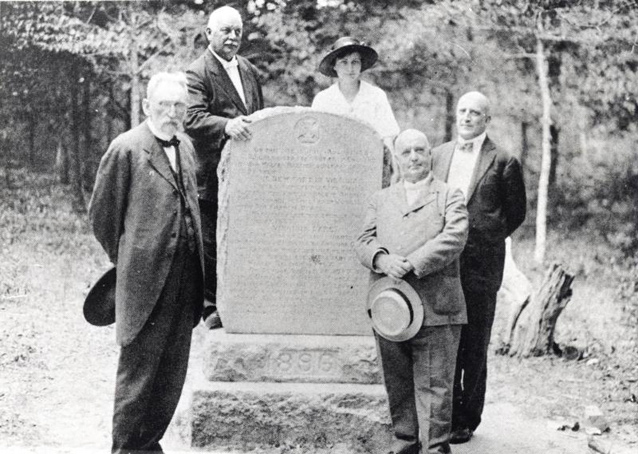
National Park Service
After these improvements, the Roanoke Colony Memorial Association focused for the next several years on paying off the debt incurred from the acquisition and development of the site. In 1910, the association sold 246 acres to William J. Griffin, leaving only the 16.45-acre tract with Fort Raleigh. Despite this and other efforts to raise funds, the Roanoke Colony Memorial Association’s debt was not retired until 1937.
While the Roanoke Colony Memorial Association in the early 1900s was consistently attempting to implement new ways to memorialize the site and raise funds, public use of Fort Raleigh was limited during the years the association managed the site, largely because of its isolated location on Roanoke Island. Not until the 1930s, under the New Deal policies of President Franklin Roosevelt, did the Outer Banks begin to see the installation of bridges and improved roadways, bringing an influx of tourism and major changes to the local economy.
In 1921, the story of the lost colony was first immortalized on film. Produced locally with a local cast, the 46-minute silent film titled “The Earliest English Expeditions and Attempted Settlements in the Territory of What is Now the United States, 1584-1591” was released to schools throughout the State of North Carolina for educational purposes. This film marked the beginning of interpretive recreations of the lost colony throughout the twentieth century.
In January 1932, a new local organization was incorporated as the Roanoke Island Historical Association. Two years later, the Roanoke Colony Memorial Association, strapped for funding, donated Fort Raleigh to the State of North Carolina. One of the newly-formed Roanoke Island Historical Association’s first priorities was to plan for the 1934 and 1937 celebrations, marking the 350th anniversary of the English expeditions. Congress did not fund the 1934 celebration, however, forcing the Roanoke Island Historical Association to withdraw sponsorship.
Despite this setback, the Roanoke Island Historical Association continued planning for the 350th anniversary of the arrival of the lost colony. As part of the preparations, playwright Paul Green was contacted about writing a script for a theatre production of the lost colony events. Green agreed and, using WPA funds from the New Deal, the Roanoke Island Historical Association contracted with Albert Bell to design and construct an outdoor theatre on the property at the Fort Raleigh site overlooking Roanoke Sound. In support of the 1937 celebration effort, Congress authorized the minting of fifty-cent pieces commemorating the lost colony. Signed into law by President Roosevelt on June 24, 1936, the bill provided for the coins to be sold by the Roanoke Island Historical Association and the Roanoke Colony Memorial Association to raise money for their efforts. In addition, a five-scent stamp was issued the same year commemorating the birth of Virginia Dare.
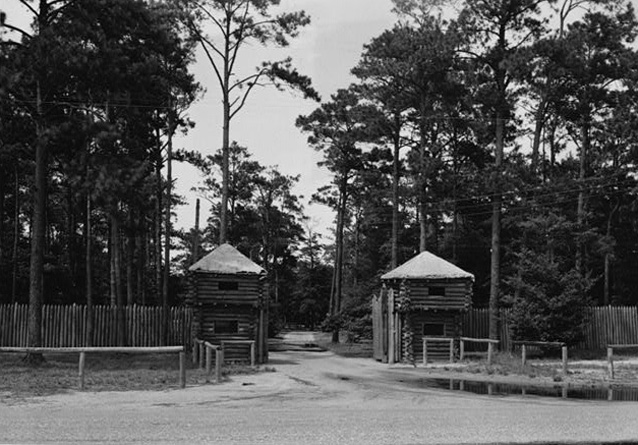
Library of Congress
During its inaugural 1937 season running from July 4 to Labor Day, Paul Green’s The Lost Colony drama was performed before fifty thousand people. On August 18, the 350th anniversary of Virginia Dare’s birth, President Roosevelt attended the outdoor drama. He gave a speech about the importance of majority rule in democracy and signed legislation authorizing the creation of Cape Hatteras National Seashore.With a successful first season, the Roanoke Island Historical Association assumed responsibility for producing The Lost Colony. The Roanoke Colony Memorial Association, its mission of drawing national interest to the site accomplished, then dissolved.
As the state historical commission and the Roanoke island Historical Association were developing Fort Raleigh, they raised the idea of turning the site over to the National Park Service. With full association support, the North Carolina Historical Commission sent a letter to the Park Service on May 8, 1936, offering the site as a national park and providing information about the New Deal development underway at the property.
There were two areas of concern among National Park Service officials. First, there was some concern that the site was not from the 1580s at all; rather, it was a fort whose remains dated to the eighteenth century. However, extensive poring over of historical and archeological records led the National Park Service to conclude that the lost colony settlement had been located on the northern end of Roanoke Island either at or near the Fort Raleigh property.
Second, part of the New Deal improvements and re-creations at the site in the 1930s included the construction of log cabin-type structures throughout, prompting concern among National Park Service officials about the historical accuracy and appropriateness of the site’s reconstructed settlement. In September 1936, an inspection of Fort Raleigh by historian Roy Edgar Appleman did little to ease concerns about development underway at the site. Appleman cited a number of problems with the reconstruction effort. The pace of the project was too fast, leaving no time for serious historical research and, more important, archeological excavations. The log buildings were historically inaccurate and the first known use of such construction techniques in the New World was in the 1630s by Swedish settlers.
Despite these concerns, the National Park Service formally recognized Fort Raleigh’s historical importance in 1939 and on April 5, 1941, Acting Secretary of the Interior Alvin J. Wirtz issued an order creating Fort Raleigh National Historic Site, which the Park Service began administering on July 21, 1941.
World War II caused a halt in modifications and improvements at Fort Raleigh National Historic Site. With German U Boats operating off the coast of the Outer Banks, The Lost Colony drama suspended production for the duration of the war. In addition, hurricane damage rendered the Waterside Theatre unusable in 1944.
In 1946, the National Park Service began efforts to remove the structures at the site that were deemed historically inaccurate, the most controversial being the removal of a “period” wedding chapel, a location that had turned the park into a “matrimonial Mecca for the local population.” The following year, archeologist J.C. Harrington began excavations of the earthwork, finding various Elizabethan-era artifacts in the process. In 1950, the earthwork was reconstructed to reflect its approximate size and shape from 1585. In 1955, the Elizabethan Gardens opened to the public.
By 1962, the last remnants of the controversial and historically inaccurate structures had been removed, when the Waterside Theatre was rebuilt in a more period-accurate architectural style. In addition, the early 1960s marked the “Mission 66” period, a period in which the National Park Service began improvements to all parks to reflect the needs of visitors who had more money, more automobiles, and more vacation time during the post-World War II era. The goal of the Park Service was to make nationwide improvements by the year 1966.
On July 13, 1966, the new “Mission 66” facilities at Fort Raleigh National Historic Site were formally dedicated. These included a new visitor center, the Outer Banks Group headquarters, the Lost Colony building, a utility building, and four residences along with park roads and parking areas.
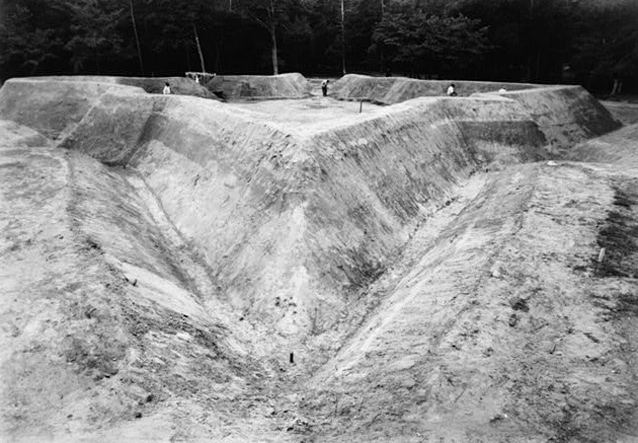
Library of Congress
Following the park's development in the 1960s, Fort Raleigh National Historic Site remained relatively unchanged until the early 1990s, when the park acquired several parcels of land from the Roanoke Island Historical Association. This brought the total acreage now under the ownership and stewardship of the National Park Service to 356.45 acres.
Presently, Fort Raleigh National Historic Site receives approximately 275,000 visits per year, with many visitors hoping to solve the mystery of the lost colony and enjoy the preserved location of the first English expeditions to the New World.
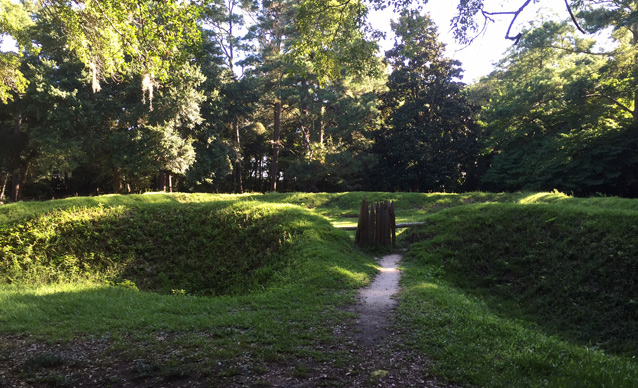
National Park Service
Last updated: May 10, 2021
